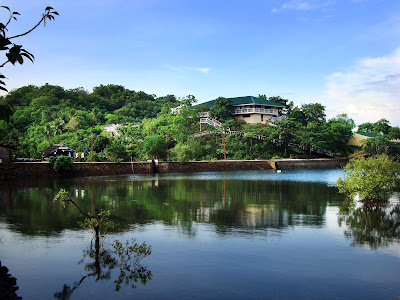Dr Abe V Rotor
To see the world in a grain of sand,
And a heaven in a wild flower;
Hold infinity in the palm of your hand ,
And eternity in an hour.
- William Blake (Auguries of Innocence)
Where birds and fish meet, sky and river;
when the world is at peace and not a stir;
when the heart throbs not of fear and pain,
but tenderness of a flower grown by rain.
Living on the ledge is a curious thing,
From one world to another world;
Where freedom is honor and pride,
And finding but the edge of a sword,
That rules the Great Divide.
Would you like to live behind bars of saplings and bushes?
where the pond creates a thousand images,
where deep down breathes life, life of the pond and the trees,
where thoughts live or die as you wish?
It looks like a monster facing the sea,
all clothed in verdant green;
it holds back the wind, wave and tide,
the evil spirit unseen.
How long will I wait and greet you a pleasant day?
But the shy creature is fast asleep in its burrow;
It can't understand your language, only that of the sea,
And kind notes and gestures more than humans know.
A nursery of mangrove starts to wean
the young plants early for the open sea;
when man by contrast would not dare
but spoils his child from being free.
And the sapling walks alone into the open,
on stakes anchored in the mud;
hello, it greets the world, and many guests,
to its shadow, confident and proud.
What is a swamp with its unkind, unpleasant name,
this forgotten domain between land and sea,
where monsters lurk, where death reigns, and life
is but an accident, where time is an enemy?
Swamp of sadness, swamp of despair, where
legends and tales are on the dark side;
yet the riches of the world from the ancient sun
here grew, the fossils coming out alive.

Pristine by the mirror of the sky,
the trees aligned on the shore;
the air in the stillness of peace,
the water emerald and pure.
Thoughts run faster than vision, often reaching no destination;
While a boatload of souls patiently waits at sea with the wind
To take them to where they are bound in work or pleasure;
Having also thoughts of their own, but aimed at their mission.
Kugtong - giant lapulapu - feared in the bottom of the sea,
its kingdom secured by its fierce look and size;
who would believe Captain Nemo of Jules Verne's book?
Oh, unless you've seen it with your own eyes.

Bridges tell us of war and peace,
bridge across a river or waterfall;
pontoon bridge in the battlefield -
memories the longest bridge of all.

Either the rock is rising or sinking, I can only surmise,
A cave on the outside, a cavern deep down below;
Wish I were a witness, or that I might be -
To the creation of a world, its transformation, too,
But I would lose the essence of awe. I wish I won't be.

To each his or her reflection, yet collectively the same and one:
the beauty of nature in a piece of rock floating,
Guimaras - a corner of Eden saved from Sodom and the Flood,
where man is led back to his happy beginning.
This
post is dedicated to the participants to the 20th Annual Conference of
the Philippine Society for Educational Research and Evaluation, May 10
and 11, 2012. I was given the honor and privilege to be one of them in
the group.

%2BA.jpg)








.jpg)
























.jpg)

.jpg)
.jpg)
.jpg)



